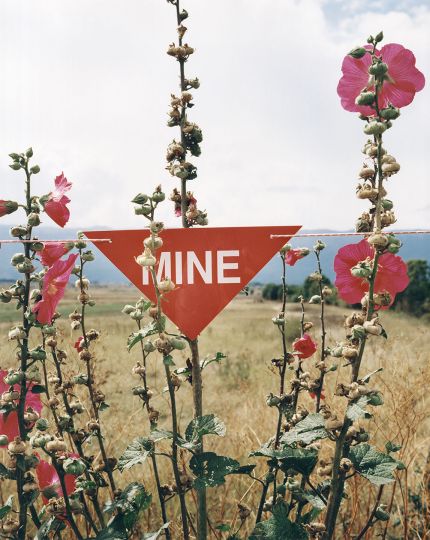
After the War, Bosnia 1995 – 1996
The series was done during the first year after the Dayton Agreement, that led to a cease-fire in Bosnia-Herzegovina. It shows the fragile balance of war and peace, remains of violence but also signs of a gradual normalisation.
Charles-Arthur Boyer
in artpress Nr. 232, February 1998:
Wolfgang Bellwinkel works somewhere between that which is hidden and that which we hide, between that which is unseen and that which we do not want to see anymore. As in Paul Graham’s pieces on the clash in Ireland, all we see in the Bosnian conflict in Bellwinkel’s work is what it has written on the landscape, the marks left by the consequences of war and a difficult transition to a civil society. But these traces are so insistent and ineradicable that they shift this work out of the realm of landscape photos and into a domain of emblematic images whose character is universal or charged by our collective imagination.
A clump of bushes in a landscape so dry and desolate that it seems destined to be used as a dump is garlanded with bright bits of debris, red and yellow wires carried along by the wind until they come to rest on these naked branches. This vision of a possible magic blossoming, sublime and unknown is fogged by a feeling of woundedness, of spilled blood, of bodies dumped and abandoned. In a magnificent clearing, a group of people in blue and brown work clothes bustle around a pit without the viewer being able to see who is doing what. In the foreground, we glimpse a fuzzy image of barbed wire. Two of the figures, wearing protective masks, are carrying a stretcher with a corpse wrapped in a sheet. A third person watches. Another photographs the scene. What are they doing there? What have they found? Any interpretation seems possible.The scene is outside of time; the drama, though invisible is almost palpable. Yet we are looking at something very precise: a mass grave near Nova Kassaba.
Sophie Ristelhuber showed us the Gulf War through a scarred and pitted land. In Bellwinkel’s work, war seems to have spilled across the landscape like guts of a corpse: intestines have become flowers, and we behold the idyllic beauty of the landscape in which an open pit has been dug. Debris remains and filth rise to the surface of the reality of this geography like images in a photographic emulsion.
www.citizenartist.org.uk:
…His photographs of the war’s aftermath are complex and layered. In the act of reading the image, and because the images require that we scrutinize them slowly and carefully, we are converted from viewer to witness. The images are imbued with contradictions and odd and subtle juxtapositions of ordinary life conducted in a context of violence. The aftermath is also after the photograph. We are always scrutinizing the past, as much as the photographer had when taking the photograph. We see only traces of what has been, and in this act of looking we too experience the contradictions that a people would have had to contend with at a specific place in time. We are embroiled in their dilemma. We unwittingly become participants in this moral pradadox and are drawn into examining the ethical implications of these contradictions and of the war itself, free of the distraction of glib and gratuitous cliches. We cannot escape with impunity. We are participants
regardless of whether we wish to be or not…
Ulf Erdmann Ziegler, im Katalog zur Ausstellung Die Welt als Ganzes:
…Eine Winterlandschaft mit zwei nahezu identischen weißen Häusern: Während das eine intakt ist und die Wäsche auf dem Balkon zum Trocknen hängt, ist das andere komplett ausgebrannt. Zwei Schornsteine ragen wie mahnende Finger in den weißlichen Himmel. Wie eine kümmerliche Fabel von der Vergänglichkeit ist das jetzt ausgebrannte Haus aufwändig eingezaeunt.
Eine andere Form schmerzhafter Symmetrie: Auf einem heruntergekommenen Schulpult hat man zwei eilig eingeflogene Standartkartons aufgestellt, die als Wahlkabinen dienen. Das Nebeneinander, die Pluralität, muss erst wieder erlernt werden. Die ruhigen Flächen des Kartons verweisen auf das unruhige Dekor des Fliesenbodens. Der Grund, auf dem Demokratie praktiziert wird, erscheint ungewiss.
Bellwinkel legt als Ausgangsform den fotografischen Essay zugrunde, wissend, das man keine Geschichte erfinden muss, um die Geschichte zum Sprechen zu bringen. Er kombiniert Landschaften, Interieurs und Portraits – in jedem noch der Schrecken und schon der Augenblick der Besinnung. Was der Fotograf vertritt, ist das Gegenteil des Eiferers. Seine komplexe Formsprache, der vorsichtige Einsatz von Farben lassen den Betrachter spüren, dass die Aufgabe zu lösen noch bevorsteht, aus den Täuschungen, Verwüstungen, der Bosheit und dem Zufall das zu filtern, was als Konsensus wird bestehen können.
























